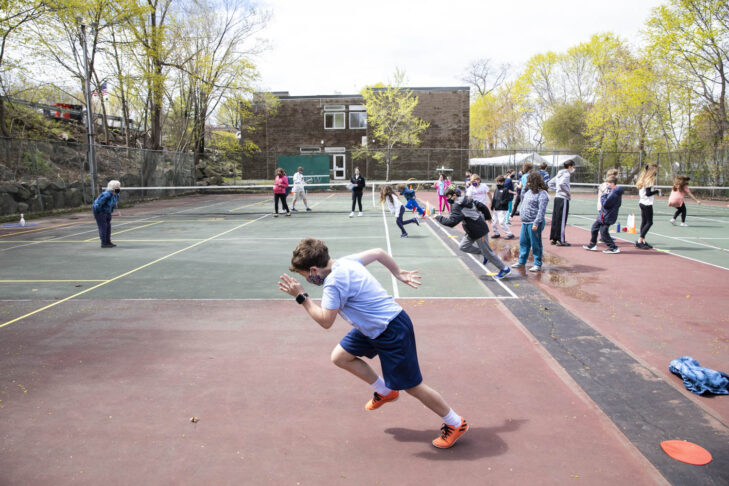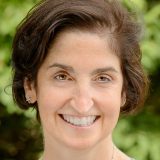Below is the speech I gave at the virtual Annual Meeting 2021:
Erev tov and thank you for joining us for the 2021 annual meeting. While I wish we were all in the Mo’adon together at school, Zoom has been the platform of choice to bring us together when we’ve had to be apart. It feels like the only appropriate way to start my remarks is with the Shehecheyanu. This blessing is one we say to express gratitude when we are doing something for the first time or marking a special occasion. The blessing first appears in the Mishna and it originates from a shorter phrase:
בָּרוּךְ שֶׁגִּיעָנוּ לַזְּמָן הַזֶּה
Baruch she’higianu lazman hazeh, which means thank you for enabling us to reach this moment.
This moment, the one where we can say our students have been in school every day, all day, for in-person learning since Sept. 1. Let that sink in.
This moment, the one where we can say that we did not have even one case of COVID transmission in school. Zero spread. Let that sink in.
This moment, when I can tell you that we welcomed 44 new students into our school and 86% of them are staying because they have experienced the EHS difference, and they can’t imagine leaving or going back to their old school. We will have 104 students at EHS next year; there were 51 when I started six years ago. Let that sink in. Truly these are moments for Shehecheyanu.
בָּרוּךְ אַתָּה יהוה, אֱלֹהֵֽינוּ מֶלֶךְ הָעוֹלָם, שֶׁהֶחֱיָֽינוּ וְקִיְּמָנוּ וְהִגִּיעָנוּ לַזְּמָן הַזֶּה
Baruch Ata Adonai, Eloheinu Melech Haolam, shehechiyanu, v’kiy’manu, v’higianu lazman hazeh
Thank you for enabling us to reach this moment. There are so many people who deserve thanks, but at the top of my list are the teachers. Never in the history of education have teachers been front line workers who had to set aside fears and concerns about their own health and safety for the greater good of our children. Never in the history of education have teachers simultaneously experienced the disruption, and demand, of having to adapt all of their instruction to masked social-distanced lessons while continuing to nurture, educate, support, and care for our children. The EHS faculty and staff did this seamlessly. Thank you doesn’t seem adequate for what they’ve endured; it’s not deep enough, wide enough, and long enough. I wish they all could stand in front of you so we could give them the standing ovation they deserve. There are only 6.5 more days of school, and then they will be able to fully exhale from the collective breath they have been holding since September. It’s been a very long road; one might even say a marathon.
Some of you may know that I am a runner. I have run dozens of road races of all lengths: 10Ks, half marathons, even 15- and 20-mile road races. The one distance that eludes me is the marathon. I also happen to be a Boston Marathon aficionado. I grew up not too far from Heartbreak Hill, and I was one of those kids handing out oranges as the runners began their trek through the infamous hills of Newton. Last week, I participated in a three-hour workshop on “Strategies for Revitalizing School Communities in September.” The keynote speaker, Dr. Chris Bellonci, a renowned psychiatrist from Tufts Medical School and Judge Baker Children’s Center, started his remarks by likening the current situation to a marathon that has wreaked havoc on the mental health of our society, especially children. We have been in a state of chronic stress without a clear end point. At least when you run a race, you know the distance you will be covering. COVID had a starting line (March 13, 2020), but the finish line is still blurry even today 16 months later.
EHS has been running this race all year. We prepared mightily over the summer; the Forward to School Task Force put in many training hours to ensure that we were ready for the opening of school. Coached by an outstanding group of physicians from the Jewish Day School Medical Advisory Board, we reimagined how school could run safely while maintaining the warmth of our community. This group of physicians, including our very own Dr. Paul Copeland, were on speed dial for any and every question, concern, or crisis as they arose. There were many hills to climb as information changed throughout the year. I am indebted to this group of people who gave so freely of their time, especially given the stress they experienced themselves as health care providers.
Without a doubt, this has been the hardest year I have ever experienced working in a school, but in the words of the Pirke Avot, לְפוּם צַעֲרָא אַגְרָא (L’ fum tzara agra), which translates to, “According to the effort so is the reward.” I am amazed and very proud of all that we have accomplished together. Every day in school was a gift. We opened the year by telling everyone that our goal was to stay in school until Thanksgiving; that was the first of the many important mile markers along our course. And the next one was the 100th day of school in February; suddenly, our destination wasn’t so far away having passed the halfway mark of our school year. We had made it through the toughest part of the journey, the winter months, when cases were climbing and we were forced indoors from our outdoor learning and eating spaces. Throughout this time period, we continued to reimagine, reframe, and reconfigure our lessons and our traditions.
You name it, we did it all this year: Kabbalat Shabbat on Zoom or the tennis courts, Thanksgiving Day of Service where we provided meals, warm bundles, and well-wishes to those in nearby communities. There were festive Purim and Passover celebrations, a seventh grade science fair, a Shavuot text study with middle school students teaching Torah to their younger buddies, and engineering projects in our new state of the art Sulman Innovation Center. Cheering us on were grateful parents, supportive board members, and happy children who skipped into school each day.
In his talk, Dr. Belonci said that although we have all experienced an unparalleled disruption in our lives, the outcome can be post-traumatic resilience rather than trauma. He explained that the greatest predictor of competency is cohesiveness and collaboration. This made me pause; it bears repeating: The greatest predictor of competency is cohesiveness and collaboration. There are many things you can say about EHS, but the word that gets used the most is community. EHS is a place where teachers and students learn with and from each other. EHS is a place where adults and children can count on each other for support, guidance, and encouragement even amidst a worldwide pandemic. EHS is a place where people celebrate each other’s joys and accomplishments, whether it’s solving a math problem, reading Torah for the first time, or just making it from one day to the next when you are worried about your health and safety.
EHS has been an oasis this year for our children, their parents, and for all of the teachers and administrators as well. For as draining as it is to teach with a mask on all day in a socially distant classroom, we know how fortunate we have been to come together and actually have school up and running. Running is what we’ve done all year: 26.2 miles. When we cross that finish line on June 17, we will be stronger having experienced things together on our journey that we never thought were possible. We are an incredibly cohesive, happy, collaborative, and caring community. I am extremely proud to have run this marathon, to lead this team and to be head of this school. Our future is very bright.
This post has been contributed by a third party. The opinions, facts and any media content are presented solely by the author, and JewishBoston assumes no responsibility for them. Want to add your voice to the conversation? Publish your own post here. MORE



